The Ultimate Guide to Digital Agency Processes [2025]
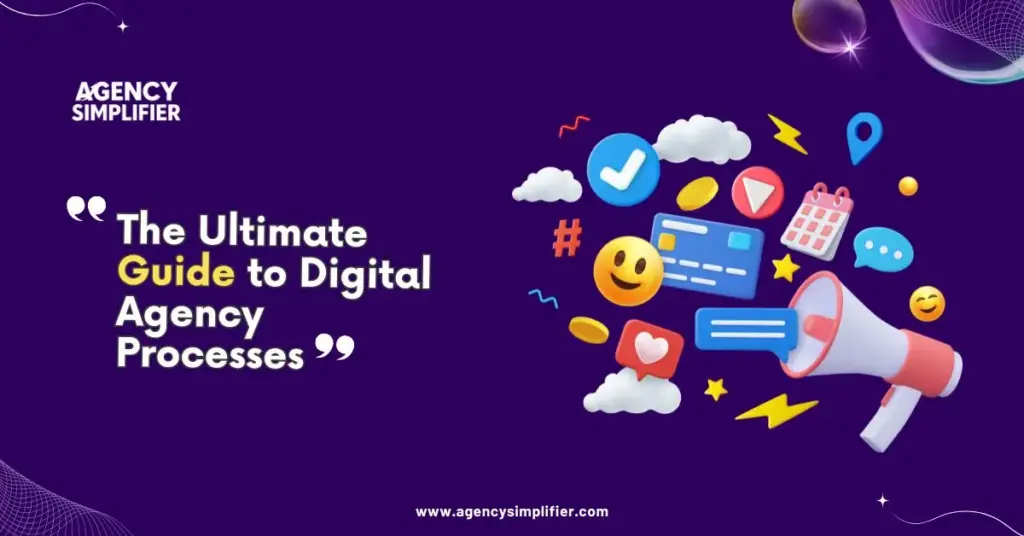
Ever wonder what makes some agencies truly shine while others just struggle? It often comes down to one thing: how they get work done. Imagine your agency running like a well-oiled machine, every team member in sync, every project hitting its mark, and clients consistently wowed. This isn’t just a dream; it’s the reality for agencies that master their agency process.
Let’s be honest. For many digital agencies, chaos is the norm. Missed deadlines, tangled feedback, and great ideas lost in endless revisions. But here’s the thing: the difference between agencies that thrive and those that just survive is a clear, defined agency workflow. This isn’t about ticking boxes; it’s about creating a reliable framework that keeps your team focused, your clients informed, and your results consistent.
This guide will show you how to build a marketing agency process that delivers, fosters teamwork, and keeps clients coming back. We’ll break down proven strategies for refining your agency workflow, explore the nuances of the design agency process, and share actionable tips for building a creative agency workflow that scales. Ready to transform how your agency works and the results you deliver? Let’s dive in.
What Is an Agency Process?
An agency process is simply the step-by-step journey a project takes, from the first client brief to final delivery. Think of it as your agency’s playbook, making sure every campaign or design follows a clear, repeatable path to success. It’s not just about checking off tasks; it’s about a reliable system that keeps your team focused and your results consistent.
While you might hear terms like agency workflow or agency workflow process, they all point to the same goal: a structured way of working. The agency process is the big picture—how your agency delivers value. The agency workflow is the step-by-step sequence within that process, like planning, creating, and reviewing. The agency workflow process gets even more detailed, covering the specific tools and steps for each stage.
Why does writing this down matter? Clear documentation sets expectations for everyone, from clients to creatives. It makes onboarding new team members easier and helps you spot bottlenecks. It also builds a culture of accountability. In short, a well-documented agency process turns chaos into clarity, letting your team focus on what they do best: delivering outstanding work.
Key Steps in a Digital Agency Workflow Process
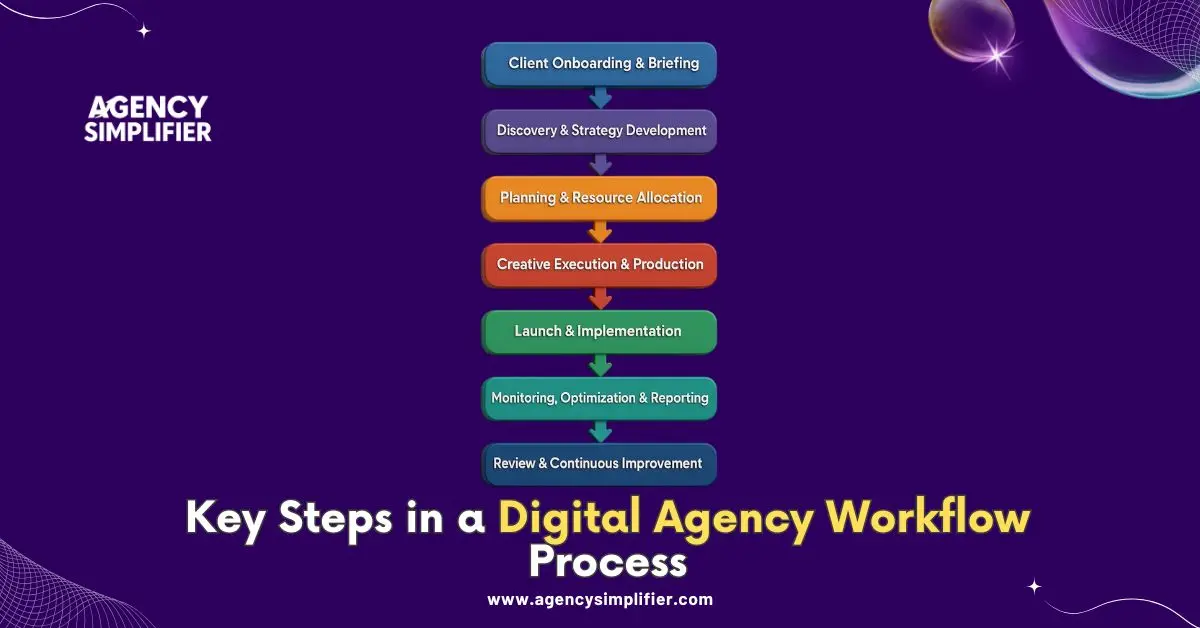
A great digital agency workflow breaks down complex projects into clear, actionable phases. Each step aims for efficiency, creativity, and client satisfaction. Here’s how the core phases typically unfold:
- Client Onboarding & Briefing: This first step sets the tone. It’s about understanding client goals, gathering requirements, and setting clear objectives. A thorough brief ensures everyone is aligned from the start.
- Discovery & Strategy Development: With the brief in hand, the team researches the market, competitors, and audience. This shapes the strategic direction, making sure every decision is rooted in data.
- Planning & Resource Allocation: Here, the agency outlines timelines, assigns roles, and allocates resources. Mapping out who does what and when helps avoid bottlenecks and keeps the project on track. This is crucial for both creative agency workflow and marketing agency process management.
- Creative Execution & Production: This is where ideas come to life. Designers, writers, and developers collaborate to produce deliverables. The creative agency process ensures quality and creativity are balanced with efficiency.
- Launch & Implementation: Once approved, it’s time to launch. This step is all about flawless execution and timely delivery.
- Monitoring, Optimization & Reporting: After launch, the focus shifts to performance. The team tracks results, gathers data, and identifies optimization opportunities. Regular reporting keeps clients informed.
- Review & Continuous Improvement: Finally, the agency reflects on what worked and what didn’t. Feedback is gathered, processes are refined, and learnings are documented. This fuels continuous improvement for future projects.
These steps apply across all agency types. A creative agency workflow process emphasizes collaboration and iterative feedback. A marketing agency process focuses on strategic planning and data-driven optimization. A design agency process prioritizes detailed briefs and visual consistency.
Types of Agency Workflows
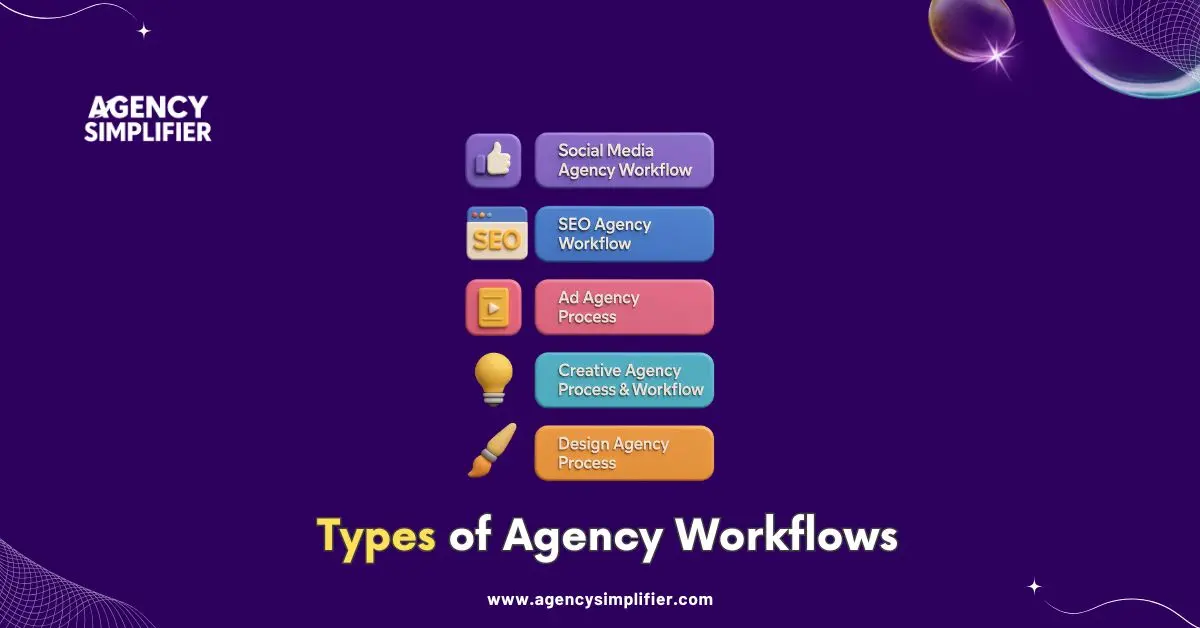
Every agency has its own rhythm, but a well-defined workflow tailored to its services is key. Here’s how workflows differ across various agency types:
1. Social Media Agency Workflow: Social media agencies focus on building brand presence and engagement. Their workflow typically involves:
- Strategy Development: Understanding client goals, target audience, and competitive landscape to craft a tailored social media strategy.
- Content Creation & Curation: Developing engaging posts, visuals, videos, and curating relevant third-party content.
- Scheduling & Publishing: Using tools to schedule and publish content across various platforms at optimal times.
- Community Management: Actively engaging with followers, responding to comments and messages, and fostering a positive online community.
- Performance Monitoring & Reporting: Tracking key metrics like engagement, reach, and conversions, then providing regular reports and insights for optimization.
2. SEO Agency Workflow: SEO agencies aim to improve organic search visibility and rankings. Their process includes:
- Keyword Research & Analysis: Identifying high-value keywords, analyzing search intent, and understanding competitor strategies.
- Technical SEO Audit: Reviewing website structure, speed, mobile-friendliness, and other technical aspects that impact search performance.
- On-Page Optimization: Optimizing website content, meta tags, headings, and internal linking for target keywords.
- Content Strategy & Creation: Developing a content plan based on keyword research and creating high-quality, authoritative content.
- Link Building: Acquiring high-quality backlinks from reputable websites to improve domain authority.
- Performance Tracking & Reporting: Monitoring keyword rankings, organic traffic, conversions, and providing regular performance reports with actionable recommendations.
3. Ad Agency Process: Ad agencies focus on creating impactful campaigns:
- Creative Concepting: Developing bold ideas and campaign themes.
- Media Buying: Securing placements across digital and traditional platforms.
- Client Approvals: Presenting concepts, gathering feedback, and iterating.
- Post-Campaign Analysis: Reviewing performance and gathering insights.
4. Creative Agency Process & Workflow: For creative agencies, it’s about turning ideas into compelling assets:
- Brainstorming: Collaborative sessions to generate fresh concepts.
- Design & Copywriting: Bringing ideas to life with visuals and persuasive copy.
- Prototyping: Developing mockups for client review.
- Feedback Loops: Integrating feedback at every stage.
5. Design Agency Process: Design agencies specialize in visual identities and user experiences:
- Client Brief: Deep dive into client needs and brand values.
- Moodboarding: Curating visual inspiration and defining aesthetic direction.
- Wireframing: Mapping out structure and user flow for digital projects.
- Visual Design: Creating polished, on-brand visuals.
- Handoff: Delivering final assets and ensuring a smooth transition.
How to Build and Optimize Your Agency Workflow Process
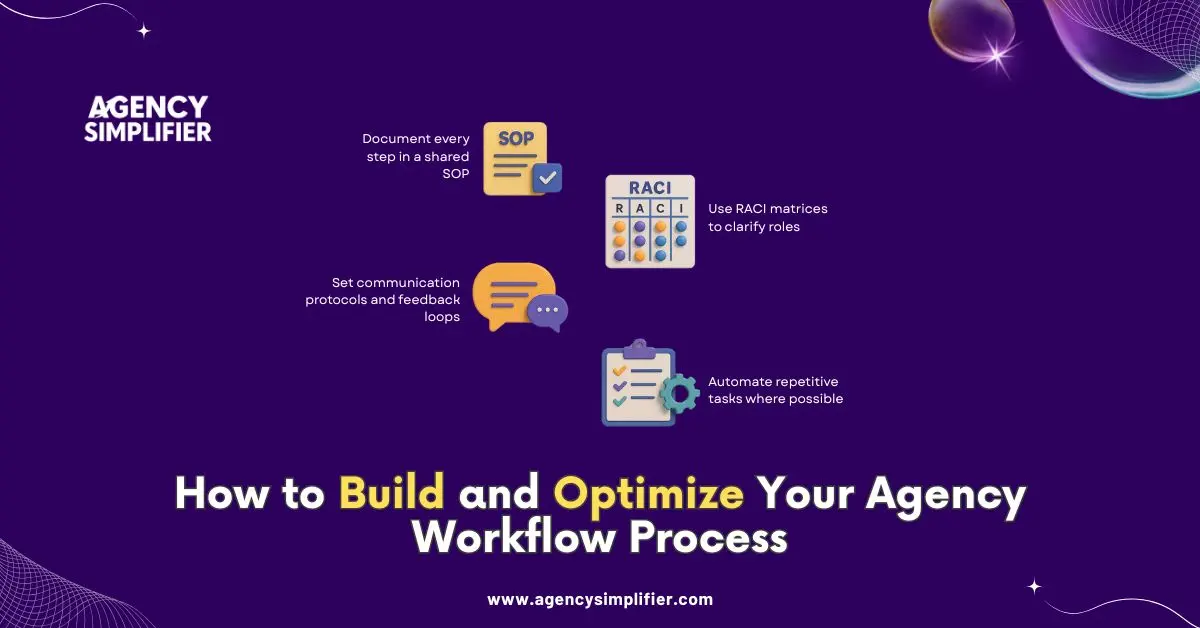
Building a high-performing agency workflow process isn’t just about mapping tasks; it’s about creating a system that drives clarity and accountability. Here are best practices to set your agency up for success:
- Document Every Step in a Shared SOP: Create a detailed Standard Operating Procedure (SOP) for each workflow. Make sure these documents are accessible to everyone, so no one is guessing what comes next.
- Use RACI Matrices to Clarify Roles: Assign clear responsibilities using a RACI matrix (Responsible, Accountable, Consulted, Informed). This cuts confusion and helps projects move forward.
- Set Communication Protocols and Feedback Loops: Define how and when your team communicates. Consistent communication keeps everyone aligned and projects on track.
- Automate Repetitive Tasks: Use automation tools for routine tasks. This frees up your team for more strategic work, boosting productivity.
To implement and improve:
- Audit Existing Processes: Map out current workflows. Identify inefficiencies and bottlenecks.
- Define Objectives & KPIs: Set clear goals for improvements and establish key performance indicators to measure success.
- Pilot with One Team/Project: Test your new workflow with a single team. Gather feedback and adjust.
- Train Staff & Iterate: Ensure everyone understands the new process. Refine based on real-world use.
- Scale Across the Agency: Once kinks are ironed out, roll out the optimized workflow across all teams. Continue to monitor and improve.
Tools & Templates to Streamline Agency Workflows
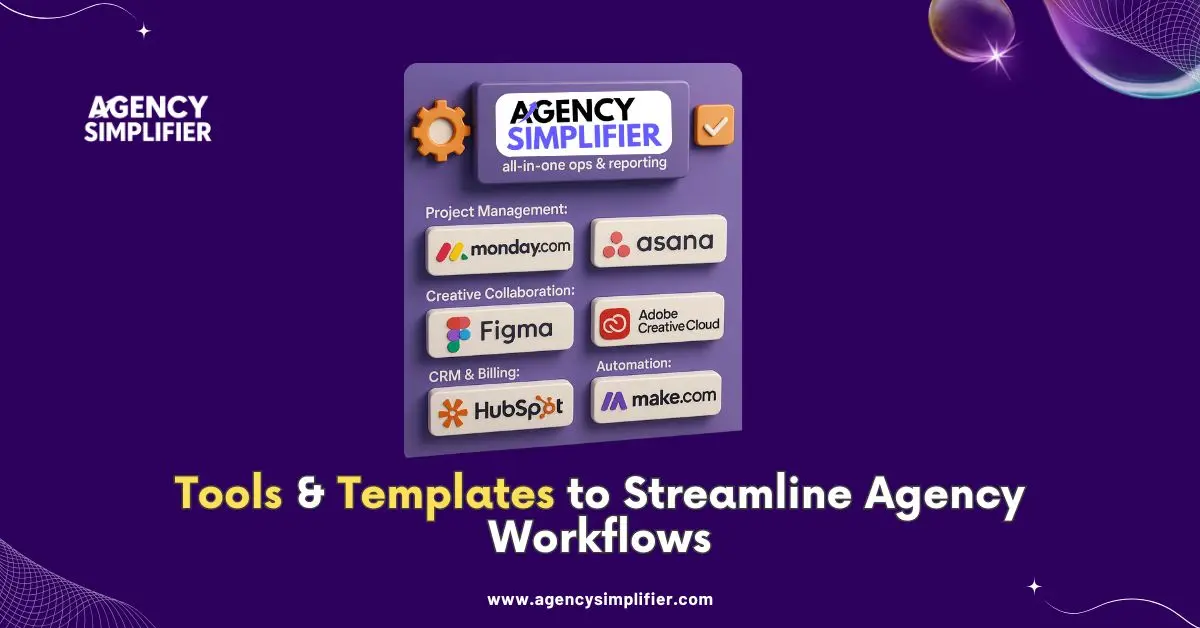
Choosing the right tools is essential for an efficient and collaborative workflow. Here are top platforms and templates agencies use:
- Agency Simplifier: An all-in-one platform for agency operations and reporting. It centralizes project management, client communications, and analytics.
- Project Management: Platforms like Monday.com and Asana organize tasks, track progress, and visualize timelines. They help teams stay on top of deadlines.
- Creative Collaboration: Figma and Adobe Creative Cloud are go-to tools for creative teams. Figma excels at real-time design collaboration, while Adobe offers a comprehensive suite.
- CRM & Billing: HubSpot streamlines client relationship management. QuickBooks handles invoicing and financial management.
- Automation: Zapier and Make.com connect apps, automate repetitive tasks, and ensure data flows smoothly, freeing up your team for strategic work.
Use standardized templates for creative briefs, project timelines, and approval checklists. These ensure consistency, speed up onboarding, and reduce errors.
Overcoming Common Challenges in Agency Processes
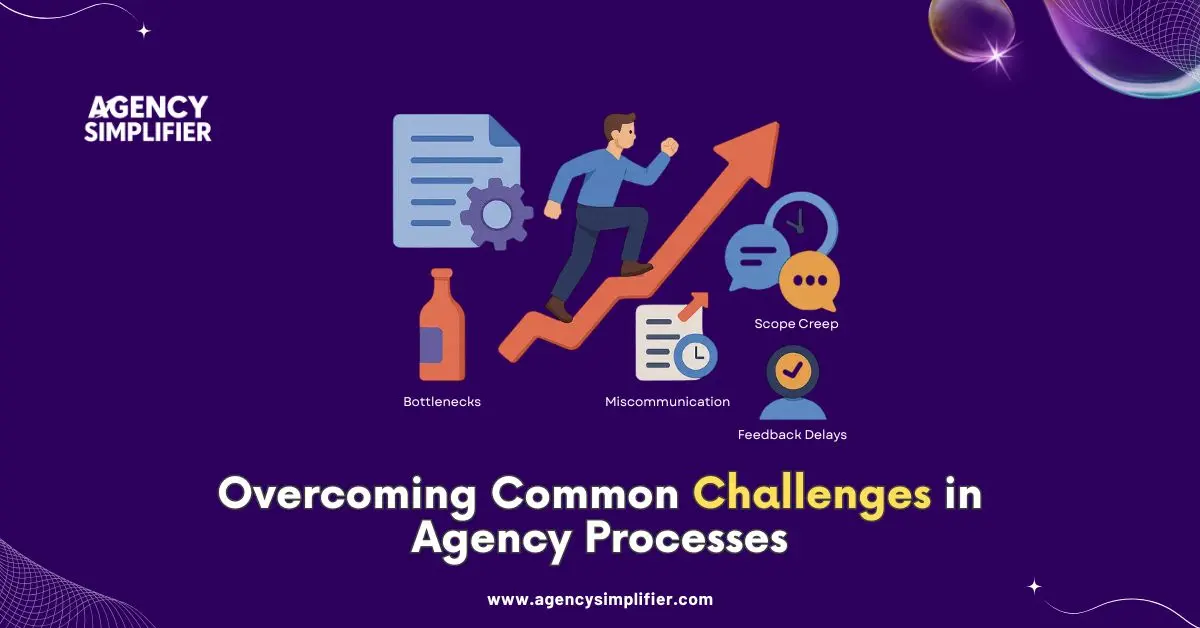
Every agency faces hurdles that can stall progress. Common issues include bottlenecks, miscommunication, scope creep, and feedback delays. Tackling these head-on is crucial for efficiency.
- Bottlenecks: Often from inefficient task management or unclear responsibilities. Regularly reviewing workflows and automating tasks helps eliminate these roadblocks.
- Miscommunication: A leading cause of delays. Centralizing communication through project management tools and structured feedback loops keeps everyone on the same page.
- Scope Creep: When project requirements expand beyond the original agreement. Clearly documenting project scope and having a change management process helps prevent this.
- Feedback Delays: Slow or inconsistent feedback disrupts momentum. Setting clear feedback timelines and using shared checklists streamline reviews.
Solutions at a glance: Better documentation, clear roles, automation, and regular process reviews. By addressing these with structured processes, agencies can deliver high-quality work on time, every time.
Future Trends in Agency Workflow for 2025
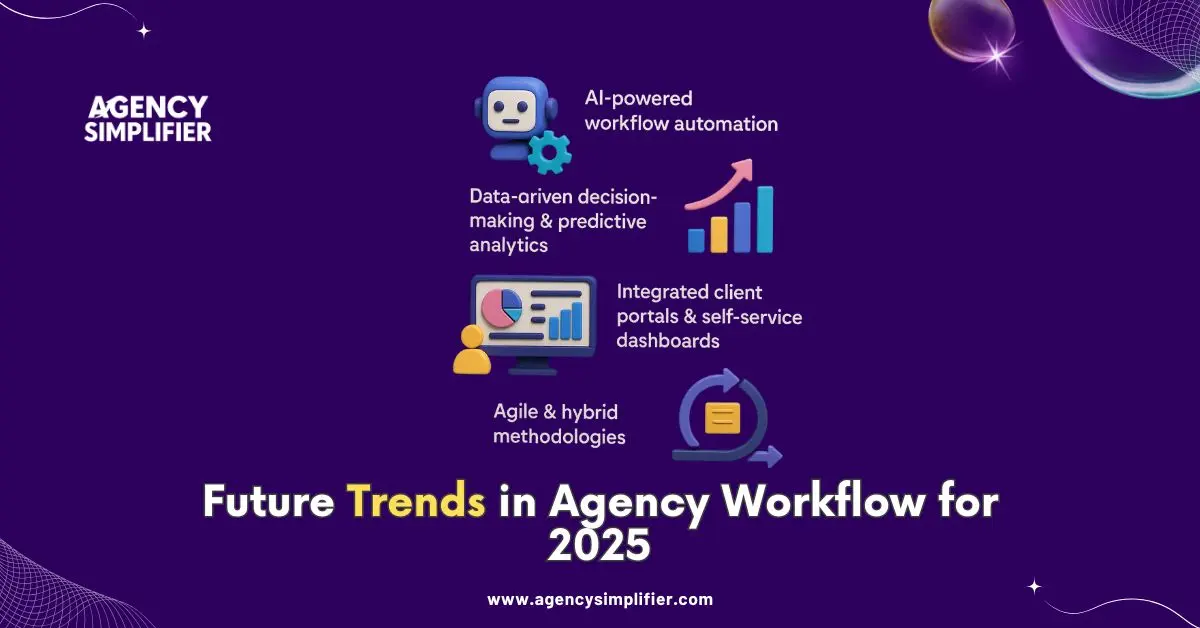
Agency workflows in 2025 will be shaped by automation, AI, and data-driven strategies. Key trends include:
- AI-Powered Workflow Automation: AI will be deeply embedded, automating tasks from brief analysis to reporting. This frees up human talent for strategic thinking.
- Data-Driven Decision-Making & Predictive Analytics: Agencies will use advanced analytics to anticipate market shifts and forecast campaign outcomes, making proactive decisions.
- Integrated Client Portals & Self-Service Dashboards: Clients will have real-time access to project progress and metrics, fostering transparency and reducing back-and-forth.
- Agile & Hybrid Methodologies: Flexible approaches will become common, allowing for quicker adjustments based on feedback or market shifts.
These trends point to more intelligent, efficient, and adaptable agency workflows, elevating service offerings and delivering impactful results.
Conclusion & Next Steps
We’ve covered the core of digital agency processes: what they are, why they matter, and how to make them work for you. A well-defined agency process isn’t just a nice-to-have; it’s essential for growth, creativity, and consistent quality. It turns potential chaos into clear action.
Key Takeaways:
- Understand the Basics: Know the difference between process, workflow, and workflow process.
- Follow Key Steps: Implement core phases from client onboarding to continuous improvement.
- Tailor Workflows: Adapt your approach for different agency types, like digital marketing agency workflow or creative agency workflow.
- Optimize: Document SOPs, clarify roles with RACI matrices, set communication rules, and automate tasks.
- Use Tools: Leverage platforms like Agency Simplifier, project management tools, and creative collaboration software.
- Look Ahead: Embrace AI, data analytics, client portals, and agile methods.
Your next step? Audit your current processes, find areas to improve, and start putting these best practices into action. Process optimization is an ongoing journey. Begin transforming your agency today for sustainable growth and success.
FAQs: Agency Workflow & Process
Here are some common questions about agency processes and workflows:
Q1: What’s the difference between an agency process and workflow?
Ans: An agency process is the big picture—the overall strategy for how your agency operates. An agency workflow is the step-by-step sequence of activities within that process that turns client needs into deliverables.
Q2: How do I choose the right process for my agency type?
Ans: Tailor it to your services, client base, and team. Audit your current operations, research best practices in your niche, and adapt them. Tools like Agency Simplifier can help.
Q3: What templates can speed up process documentation?
Ans: Use templates for Standard Operating Procedures (SOPs), creative briefs, RACI matrices, project timelines, client approval checklists, and performance reports. These ensure consistency and efficiency.
Shripad Deshmukh
Shripad Deshmukh, founder of Agency Simplifier, brings over 15 years of experience in custom SaaS development and product management. With a strong focus on digital transformation and multi-platform customer experiences.